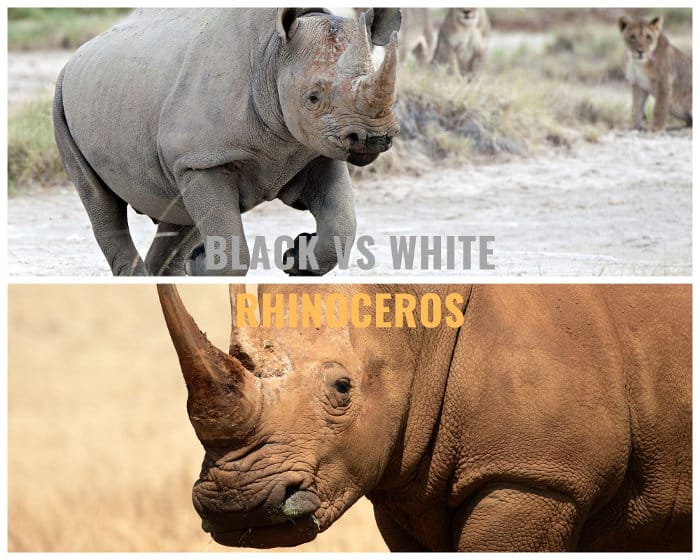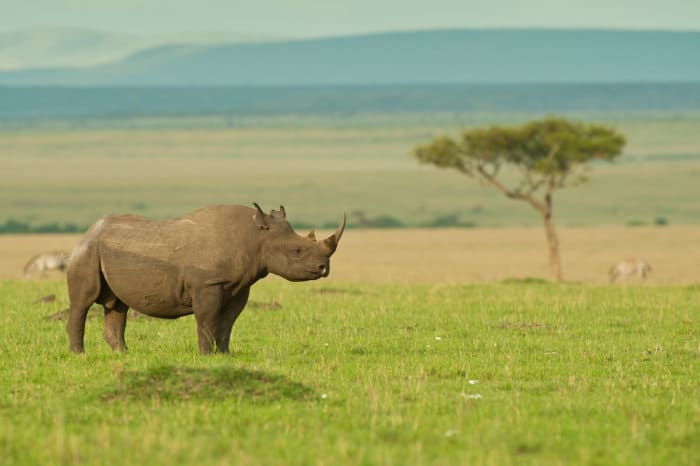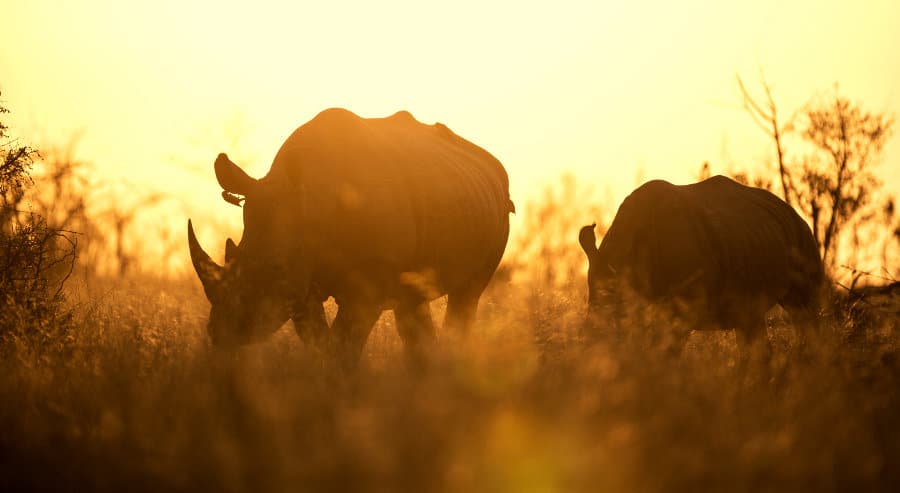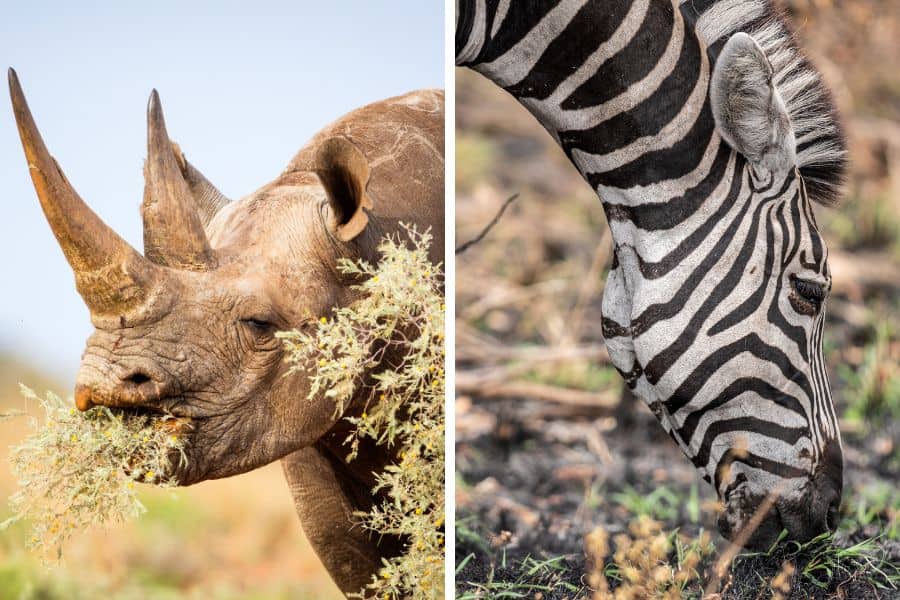What do rhinos eat when they are wandering the great plains of Africa?
Mostly they eat leaves, grass, foliage which includes twigs, bark, fruits and roots. Rhinos are herbivores, meaning they gain all of their nourishment exclusively from plants.
It takes a large quantity of plant matter to sustain such an impressive bodyweight – rhinos weigh 700-2000 kg!
Different rhino species seek out different types of plants to eat. What they eat, where they source their food, and how their body adapts to food correlates with where they live.
Not all rhinos are the same as you will discover when reading the full story of what do rhinos eat.
How does habitat impact what rhinos eat?

The white rhino typically lives in terrain that is characterised by open grassland alongside some woodlands in Africa (referred to as ‘savanna’).
They are grazers, meaning they mainly feed on low-growing vegetation like grass and supplement that with the foliage they can access.
They maintain their impressive weight thanks to the wealth of different types of grasses on the savanna – there are over 200 different varieties in some areas!
Black rhinos mostly live in the east side and centre of Africa. Their bodies are designed to source nutrition based on the terrain of those regions.
When you travel to countries like Kenya, Namibia, South Africa and Zimbabwe you can picture some bush, lots of grasslands and a fair amount of woodlands.
In these regions, given the scarcity of high-calorie plant foods, what do rhinos eat?
What do black rhinos eat?

Black rhinos source nutrition in unusual places – they’re unbelievably well-nourished by twigs, thorny bushes like Acacia trees, foliage from low-growing trees and bushes.
In fact, their eating habits play an important role in keeping the bush and foliage from overgrowing.
The black rhino’s substantial munching keeps the bushes in check, providing space for the many different grass species that support smaller chains of life.
What do white rhinos eat?

White rhinos tend to dwell in the tropic and sub-tropic grasslands and are well-adapted to consume vast amounts of grass and low-growing plants. For most of the year, they feed on shorter, lush grasses that are only 1 millimetre in height.
During the dry season, they graze on longer grasses like red oats grass and buffalo grass.They’re designed to thrive in harsh conditions – did you know the white rhino can comfortably survive for 4-5 days with no water?
A white rhino’s useful adaptations
Their wide grazing mouths are perfect for consuming a vast amount of calories in foods that are not very calorie-dense. In order to achieve this, they’re fast eaters. They can consume grass faster than a person would be able to mow it.
White rhinos also have another special skill – they’re able to eat a number of plants that are toxic to other animals and by doing so, they keep the grazing safe for the other animals.
The difference between black rhinos and white rhinos

With each type of rhino being adapted to thrive on a different type of terrain, we have grazers and browsers. If you guessed that black rhinos are browsers, you’d be correct.
Much like cattle, horses, and other grass-feeding animals, white rhinos are categorised as grazers.
Black rhinos tend to munch from higher up – consuming foliage and branches and barely eating any grass. There are also a number of other telltale signs that will enable you to distinguish between a grazer and a browse instantly on site.
Find out all about black rhino vs white rhino.
Easy ways to distinguish white rhinos from black rhinos
White rhinos have large square jaws designed to grip and extract a large clump of grass at one time.
Their mouths also have an obvious flatness, enabling them to skim along the ground and get close enough to eat their favourite young green shoots that are only a millimetre high.
Moreover, their heads are usually stooped, in contrast to browsing rhinos, like the black rhino.
You can also distinguish black rhinos from white rhinos by their colouring and size – white rhinos are significantly larger and obviously heavier. However, these traits are only truly apparent when the two cousins are side-by-side for comparison.
How to identify a black rhino

The black rhino loves to consume vast amounts of roughage like twigs and thorn bushes which typically grow at eye level. As a result, their posture tends to be straighter.
They’re also known for their slightly hooked lip which is probably the easiest way to identify them as browsers. That hooked lip is the ideal tool to reach for foliage.
Black rhinos are not well adapted for grass eating and this is apparent when you see how well they pull hanging fruits and other hanging foods down from the trees, using their mouths.
How much do rhinos eat?
Rhinos do most of their grazing and browsing when the sun is lower in the sky, at dawn and dusk.
They take rests every few hours during the hottest period of the day.
In order to maintain their impressive size on a plants-only diet, rhinos have to eat around 54 kilograms of food per day. That roughly equates to around 2.5% of their own body weight – per day!
Rhinos will absorb a substantial amount of their consumed calories, and create around 22 kilograms of dung per day, which is usually divided between 20 and 30 piles.
In fact, males use their dung to alert others of their presence. They’re shy creatures who don’t often group together and use their dung to ensure they can enjoy their personal space. Rhino dung piles are known as ‘middens‘.
Discover More About Rhinos

Now you have discovered what rhinos eat, how about how fast is a rhino? Or how about seeing a rhino on an African safari.
You may need to move fast, because both white and black rhinos are highly endangered. The bad news is that poaching continues – three rhinos are lost to poachers every day in South Africa!
The good news is that some of their populations are now stable or increasing. So we hope these animals will continue to thrive for millennia to come.



